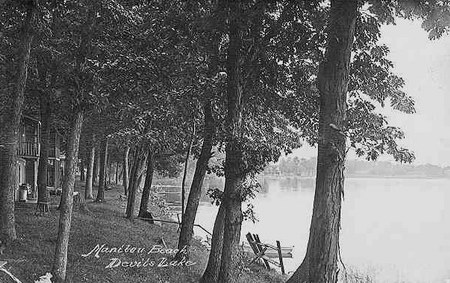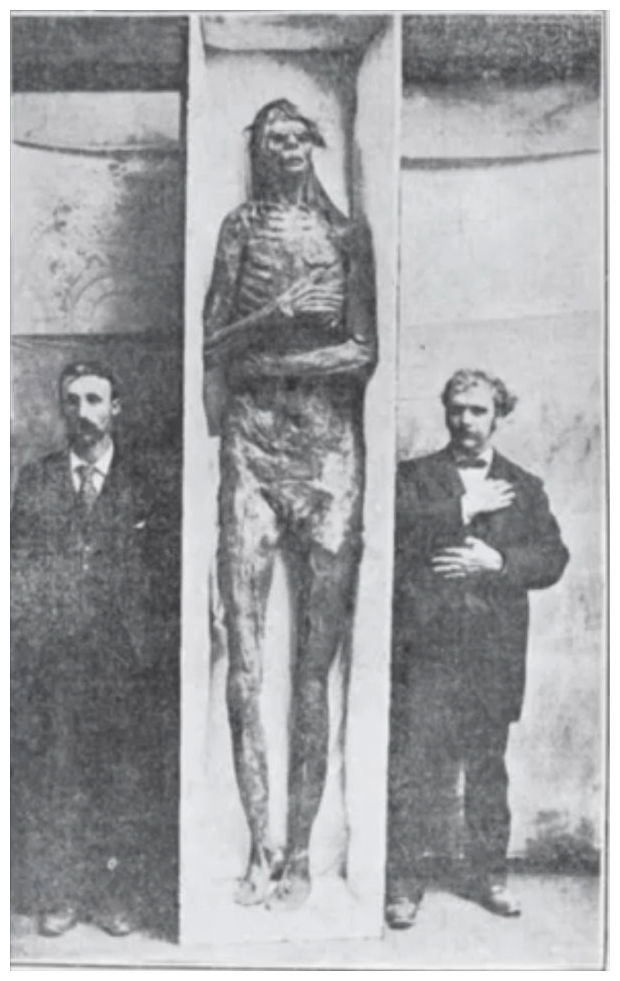STORY LINKS
Devil's Lake
Indian Giants
Mysterious
Lake Michigan
Le Nain Rouge
Paul Bunyan
Sleeping Bear
Dune
Valley
of the Giants
History of
Antique Bottles
Michigan
Salt Mines
Kitch-iti-kipi
Eastern Massasauga
Osage Orange
Past Articles
Questions, comments, submissions, & advertising
Contact BPP
|

 Michigan Chronoscope - Stories on the fringe of history
Michigan Chronoscope - Stories on the fringe of history
Chronograph Numeral IV - Fall 2017 - Page Two
|
Manitou Beach on Devil's Lake
 Old postcard photo of Manitou Beach
Old postcard photo of Manitou Beach
There's an old place name on some maps of Newaygo County Michigan called Devil's Lake Corners near the corner of 24th Street and Stone Road just a couple miles northwest of the city of Fremont. Dudley Lake is on the southwest corner of 24th and Stone and was once known as Devil's Lake. I haven't found anything online with a specific reference to why Dudley Lake was once called Devil's Lake, but the original name likely related to the local Native American tribal place names and mythology. There is another Devil's Lake in Lenawee County (SE lower peninsula) that has historic accounts of the native myths that gave rise to its name so it seems likely a similar story is behind the Dudley/Devil's Lake name in Newaygo County.
Devil's Lake in Lenawee County is an English translation of the Native American name for the lake they once called "Matchi Manitou". Matchi Manitou is a local Native American word for a nature spirit that is associated with a body of water. It could be thought of as the greatest of the water spirits, one that could bestow blessings and curses. It could be a jealous god wreaking vengeance if not appeased or like a genie whose granted wishes come true with strings attached. The Manitou legends are found all through the Great Lakes region into Canada and is what gave this lake its original name.
Devil's Lake (Matchi Manitou) had gotten its name from a native legend of the Powtawatami leader Meteau after his daughter, a good swimmer, drowned in the lake, her body never to be found. Meteau believed she was taken by an evil water spirit called the Matchi Manitou. Until around 1830, Devil's Lake was the location of a Powtawatami village. There is an area at the south end of the lake called Manitou Beach, perhaps the location where Meteau's daughter disappeared.
The first settlers arrived in 1833 and the Devil's Lake post office was established in 1885. Manitou Beach became a station on the Cincinnati, Jackson, and Mackinaw Railroad line and a popular resort town by the turn of the 20th century. Its population outgrew the similar-sized community of Devil's Lake at the lake's north end. Steam-powered ferry boats launched tourists from the train depot to the hotels and other attractions including bathhouses, a dance pavilion, boat rentals, a water slide, picnic areas, and restaurants.
Perhaps due to coincidence or perhaps due to the cursed nature of Devil's Lake, Manitou Beach was hit by an F4 tornado on Palm Sunday, April 11, 1965. It did some major damage and destroyed the dance hall and two churches that were later rebuilt. The popular tourist destination finally saw its end in 2010 when the Devil's Lake Drive-In-Church and the drive-in theater closed down along with the Manitou Beach Inn burning to the ground. Today there are still some cottages for rent near Devil's Lake, but it is mostly private homes there now.
Comment about this article on the
Epress Forum Board
.
|
|
Ancient Indian Giants
 1895 San Diego Giant An 8 foot 4 inch Tall Mummy
1895 San Diego Giant An 8 foot 4 inch Tall Mummy
Genesis 6:4 "There were giants in the earth in those days; and also after that, when the sons of God came in unto the daughters of men, and they bare children to them, the same became mighty men which were of old men of renown."
A modern myth has been circulating about a prehistoric tribe of gigantic, fair-skinned, red-haired Native Americans. It is claimed these giants were from an ancient tribe that predates the historical tribes. They are said to have been eight-plus feet tall and extremely aggressive cannibals. Often this myth has the giants driven off by normal-sized natives when they moved into their historic tribal lands or that they hunted them to extinction simply in order to survive.
This modern myth seems to have evolved from the Lovelock cave story, claimed to be a Piute Indian legend about a tribal battle with red-haired cannibal giants. The myth states that the giants retreated inside the mouth of Lovelock Cave where the Piutes burned them out and killed them all. The original story was actually about the Piutes having a skirmish with normal-sized members of another tribe.
Naturally, a person six and one half to seven feet tall is what a sixteenth-century Native American or European explorer would consider a giant while today that person is only considered very tall. This doesn't mean that there haven't been larger "giant" sized natives in existence before and during European contact. Early European historic documents report encounters with large natives in various regions.
From 1514 to 1516, Pedro Salazar, a Spaniard from the Santo Domingo colony, went on a slave-hunting trip that brought him to an area he called "the Land of Giants" between the coast of Georgia and Cape Fear South Carolina. In 1519-1522, Ferdinand Magellan encountered giant people on the coast of South America. The top of the European sailors' heads only came up to around the native's waists making the natives around nine or ten feet tall. Magellan called these giant natives Patagonians.
There is documentation of giant human remains found in ancient North American native burials. Although late nineteenth to early twentieth-century newspapers had reports of giant skeletons found in burial mounds, modern archeology considers these stories exaggerated or fabricated "yellow journalism" and without any scientific merit. The red hair found on remains is explained as a natural effect of time, climate, and soil chemistry. There is also the probability of hoaxes with these so-called giant remains.
However one of our oldest and most respected institutions, the Smithsonian Institution, has numerous official reports substantiating giant Native American remains. Many Smithsonian reports are of native skeletal remains having a height between seven and eight feet tall. These reports contradict a popular conspiracy theory that the Smithsonian has repressed evidence by claiming to have lost it or by destroying it after its discovery.
12th Annual Report of the Bureau of Ethnology to the Secretary of the Smithsonian Institution 1890-1891, published in 1894. Native American burial site in Kanawha County, West Virginia.
"Nineteen feet from the top the bottom of this debris was reached, where, in the remains of a bark coffin, a skeleton measuring seven and one-half feet in length and nineteen inches across the shoulders, was discovered. It lay on the bottom of the vault stretched horizontally on the back, head east, arms by the sides . . . "
Comment about this article on the
Epress Forum Board
.
|
|
Keywords: Michigan, Great Lakes, history, amazing, astonishing, baffling, bizarre, cryptic, curious, different, extraordinary, forgotten, hidden, incredible, inexplicable, legends, lore, lost, myths, obscure, odd, peculiar, rare, stories, strange, surprising, tales, unexplained, unfamiliar, unique, unknown, unusual, weird
|
|



